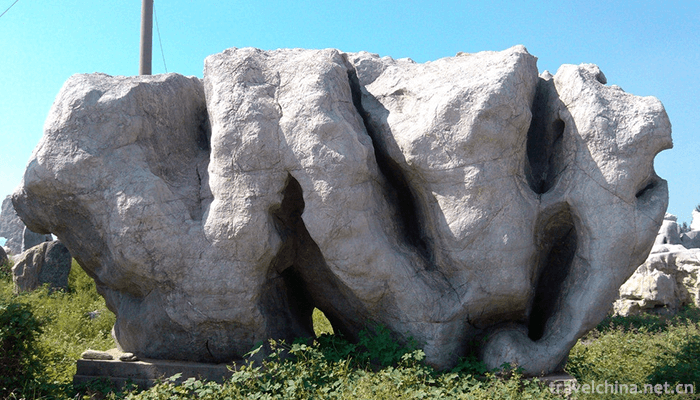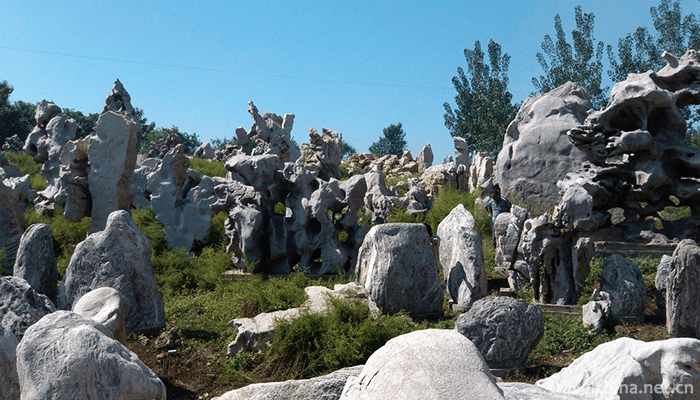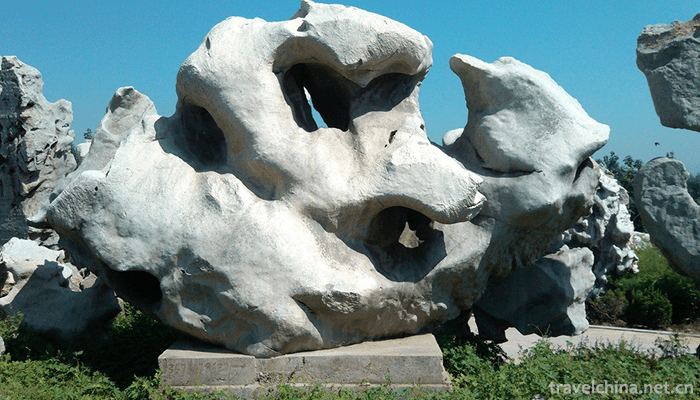Located one kilometer north of Feixian Town, Linyi City, Shandong Province, China's largest ornamental stone base, national AAAA scenic spot, Shandong Province's key cultural tourism industry projects, provincial land and resources department's key development projects, Linyi City's key projects. With a total investment of 1.02 billion yuan and a planned area of 4,000 mu, it lays equal stress on both tourism development and trading of exotic stones to build the largest exotic stones trading market in China, the exotic stones leisure tourism resort with mountains and rivers, and the unique exotic stones commercial street in Shandong Province. In May 2017, the National Tourism Administration gave it the delisting treatment.
Summary
Located in the northern suburb of Feixian County, the old revolutionary District of Yimeng, Linyi City, Shandong Province, China Qishicheng, with a total planning area of 8 square kilometers, is located in Ronghezhuang and Gaijiadong Village in the north, 327 National Highway in the south, Baicao Garden in the West and Tacheng Road in the east, with a total investment of 1.02 billion yuan. The first phase of the project covers an area of 4,000 mu. According to the layout design concept of "town in town, village in town, scenery in village, scenery in scenery" and relying on Tianlao Stone Valley as the center, the scenic spots of Qishi Commercial Street, Hongyun Town, Longyuan, Suiyuan, Meiyuan and Haitangyuan are elaborately created.
The scenic spot takes the exotic stone culture, garden and entertainment as its main line, and integrates exotic stone display, garden appreciation, leisure and entertainment, and folk culture to realize the interaction between business and tourism and the blending of real scenery. More than 20,000 pieces of strange stones are purchased and installed in scenic spots; more than 15,000 trees are planted, more than 1.5 million shrubs are planted, and 91,000 square meters of lawn are planted; the first phase of the commercial street project covers 15,000 square meters, with 67 businesses entering the garden, and has been put into operation; the second phase of the Commercial Street project covers 17,000 square meters, which is invested and constructed by Beijing Taifengyuan Investment Management Co., Ltd. and is now in operation; and the Qishi Guild Hall is built. The land is 35 Mu and the building area is about 15700 square meters. Fang Xinquan Master Garden invested 26 million yuan and is expected to be put into operation in January 2016. Fujian Bendi Amusement Co., Ltd. invested in the construction of Fujian Shun Amusement Park, covering 35 mu. It has completed 20 million yuan investment and built 18 amusement projects such as Water Paradise, Terror City and Jungle Flying Rat.
Feixian Chinese Qishicheng is a national AAAA tourism scenic spot, Shandong key cultural tourism industry project, Shandong Province Land and Resources Department Qishi resources protection key development project, Shandong Province popular science demonstration education base, Linyi City key tourism development project, Linyi University Teaching Sketch base, Shandong Province photography creation base.
In the next step, according to the idea of "expanding eastward and extending northward", the existing scenic spots will be elaborated to highlight the local cultural characteristics. The new planning and construction of Bagua Array and Feixian Stone Trade Center will expand the area from 3000 mu to 8000 mu mu, so that the East and West export of the whole Chinese Qishicheng tourist area will be located on the main tourist routes connecting Yinzao Tianmeng scenic spot of Yimeng Mountain. (Quoted from Shandong Provincial Government Network)
China Qishicheng has invested 460 million yuan. The park road stretches everywhere, like a distant link, connecting all the projects of Qishicheng. Looking at the garden, the front and back of the house, the stone hall beside the road, the green carpet and the sea of flowers, the willow fence, the winding path leads to seclusion. Infrastructure construction of hydropower, communication and water conservancy is complete.
In the rockery garden, the unique black stones of Feixian County are piled up, the black pine is emerald, and the mountain is naturally beautiful. The combination of ingenuity and natural mind has a quiet and elegant meaning.
From the rockery garden to the west of Yimeng Road, you can see the Qishi Guild Hall which has been completed in the main project. This is an important project to serve the art and business exchanges in Chinatown. The construction area of the project is more than 15,000 square meters, with an investment of 100 million yuan.
Feixian is the home of
ornamental stones in China. Qishicheng is a national 4A-level tourist area, a
tourist leisure shopping block in Shandong Province and a popular science
education base in Shandong Province. Feixian has the largest buried Stone
Forest in China, and the "Feixian stone" is praised by experts as
"the greatest natural miracle discovered in northern China at the turn of
the century". Qishicheng is based on the "Feixian Stone"
resources, implanting Qishi transactions into the real world, building a
comprehensive trading and composite experience platform to enhance the market
value of tourism, enrich the tourism industry system with the market, and
realize Business-tourism interaction and real-world trading. The Park covers an
area of 8,000 mu, the first phase covers an area of 3,000 Mu and invests 1.02
billion yuan. With the exotic stone culture, gardens and entertainment as the
main line, the park will construct four major sections: exotic stone
exhibition, garden appreciation, leisure and entertainment, and folk culture.
The project breaks through system and function restriction, integrates into
reality, integrates physical and practical use, and realizes tourism functionalization
and transaction experientialization. Centered on the Tianling Stone Valley in
the central part of the country, around which are Longyuan, Qishi Tourism
Business Neighborhood, Zodiac Garden, 12 Constellation Garden, Plum Garden,
Begonia Garden, Stone Forest Show, Amusement Park and other scenic spots in
turn, "Feixian Stone" exhibits a variety of styles in the actual
scenery of various projects.
Scenery
Qishicheng South Gate, Ruiyi Stone Kirin, standing in front of the Tao, Tuxiangnarui, welcomed eight stone visitors to the wonder. "Chinese Qishicheng" Five Bold brushwork, strong ink marks of the face big characters, highlighting the unique atmosphere of Qishicheng smart, vigorous and heavy style.
On both sides of the road, such as the stone forest exhibition hall where the waves overlap, all the stones are gathered together to make a wonderful fight. The stones are vivid and illusory. Read Shiyun carefully and understand it. Contains the world, contains all kinds of nature, all kinds of customs. The world's affairs, step stone forest seems to be available. Brush off the thick earth veil for hundreds of millions of years, condense and integrate such magnificent and magnificent spirit, personality, mind gradually open, meaning quiet and tranquil.
Stone Forest Labyrinth, Stone Shadows, Mutual ingenuity, fun and natural.
The sounds of the water are clear, the sounds of the water are clear, the wind is cold, the waterfalls are flying and the music is endless. People can stand at the top of the cliff and watch fish, listen to fairy sounds and calm their hearts.
After the valley, there will be stone in Yimeng Yimeng residential landscape, let people understand the essence of a section of Yimeng people's life.
Dragon Garden and Phoenix Dance Garden are opposite to each other, expressing the auspicious and festive mood, as well as wishes and blessings for a happy life. In Feilong Garden, the Six Dragons annotate the development and evolution of all things in the world, which is amazing.
Qishi Commercial Street with rich cultural connotations is a complex of buildings in Ming and Qing dynasties. Flying bucket arch, carved beams and painted pillars. Green bricks, green tiles, wood carvings. Arrive among them, simple and heavy breath around the body, suddenly, there is a sense of crossing. Interior full of cultural and artistic treasures, people think that opened the door to sesame. Wonderful Stone Painting, Antique Specialty, Handicraft... Between the pitch, there are treasures.
In the next step, China Qishicheng will focus on building zoos, rockery gardens, greenstone forests, urban sculpture gardens, Shiganniang Daochang, Faixian Celebrity Park and other series of Qishiyuan gardens, restoring ancient buildings such as Hongyun Temple and Taishan Xinggong Palace, and increasing the number of visitors to participate in the project. In the next three years, with the construction of related node projects and the advancement of phase II projects, the whole park will be built into a magnificent and magnificent new paradise for Yimeng people's livelihood.
China's Qishicheng will be a more perfect gesture, like a pearl, to attract visitors from all over the world and share the rare treasures of prosperity.



0 Questions
Ask a Question
Your email address will not be published.